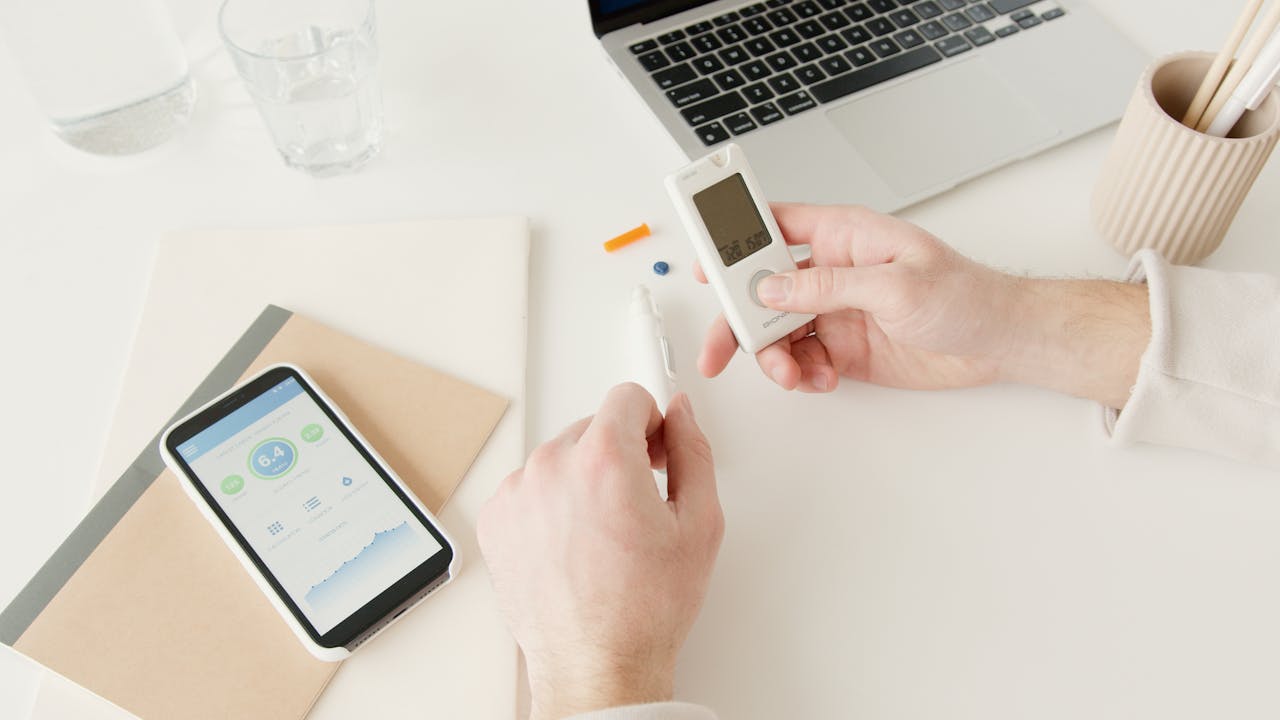Modern healthcare is undergoing a seismic shift. Gone are the days of paper records and disjointed systems. Today, tech-driven changes are streamlining processes, enhancing patient outcomes, and reshaping care delivery. This guide explores the profound impact of these innovations, backed by insights from McKinsey, WHO guidelines, and global industry analyses.
At its core, this evolution prioritises efficiency and accessibility. From electronic health records to AI-powered diagnostics, tools once considered futuristic are now standard. McKinsey reports that hospitals adopting these solutions see 30% faster decision-making and 20% reductions in administrative errors. Such advancements aren’t just convenient—they save lives.
But how did we get here? Early automation focused on simplifying tasks like appointment scheduling. Now, machine learning predicts outbreaks, while telemedicine bridges gaps in rural care. WHO data highlights a 45% surge in remote consultations since 2020, proving tech’s role in building resilient health systems.
In this article, we’ll unpack these developments. We’ll examine real-world applications, discuss challenges like data security, and spotlight emerging trends. Whether you’re a practitioner or simply curious, our goal is to clarify how these changes affect us all.
Key Takeaways
- Tech-driven innovations are reducing errors and accelerating care delivery in medical settings.
- AI and machine learning now play central roles in diagnostics and resource management.
- Remote consultations have grown significantly, improving access for underserved communities.
- Global organisations advocate for balanced tech adoption to maintain patient trust.
- Future trends include predictive analytics and expanded wearable device integration.

Introduction to Digital Healthcare Transformation
Medical practices today are being redefined by innovative solutions that prioritise efficiency and accessibility. At its heart, this shift focuses on integrating tools that enhance treatment accuracy while reducing operational friction. Let’s explore what this means for those delivering and receiving care.
Defining Transformation in Modern Care Systems
When we discuss transformation in this context, we’re referring to the strategic adoption of technologies that elevate service quality. Think of systems that allow doctors to access real-time test results or platforms enabling patients to track prescriptions digitally. These innovations aren’t just upgrades—they rebuild workflows from the ground up.
Traditional models often struggle with delayed communications and fragmented data. Modern tools address these gaps by creating unified networks. For example, cloud-based records let specialists collaborate instantly, even across states. This cohesion directly translates to better outcomes for individuals under treatment.
Paving the Way Forward
Our journey began with basic digitisation efforts, like scanning paper files. Today, we’re seeing AI analyse X-rays and wearable devices monitor chronic conditions remotely. Each step tackles specific challenges: reducing wait times, minimising human error, and extending support to rural areas.
Adoption hasn’t always been smooth. Many institutions initially resisted due to costs or staff training hurdles. However, early adopters demonstrate clear benefits—clinics using automated systems report 40% fewer scheduling conflicts and 15% higher patient satisfaction. These successes create a roadmap for others to follow.
For care teams, embracing these changes means shifting from reactive to proactive approaches. It’s about working smarter, not harder—and ultimately, ensuring every decision centres on those needing help most.
Understanding How Digital Transformation Is Revolutionising Healthcare Delivery
Advancements in tech have fundamentally altered how medical services operate. What began as simple digitisation now shapes every facet of patient management. Let’s explore this journey from rudimentary tools to intelligent systems powering modern care.
The Evolution of Digital Technologies
Early systems focused on replacing paper charts. Today, they predict epidemics and personalise treatments. This progression mirrors broader shifts in how healthcare organisations approach problem-solving.
| Era | Technology | Impact |
|---|---|---|
| 2000s | Electronic Health Records | Centralised patient data |
| 2010s | Telemedicine Platforms | Expanded access to care |
| 2020s | Predictive Analytics | Early disease detection |
Data analytics now help hospitals allocate resources smarter. For instance, some clinics use real-time dashboards to reduce bed shortages by 25%. These tools don’t just crunch numbers—they guide life-saving decisions.
Healthcare professionals play a vital role here. Nurses inputting vital signs into tablets enable instant analysis. Doctors compare treatment outcomes across regions using shared databases. This collaboration fuels continuous improvement.
Consider Johns Hopkins Hospital’s sepsis prediction model. By analysing historical records, their AI alerts teams to at-risk patients 12 hours earlier than traditional methods. Such innovations showcase tech’s power when paired with human expertise.

The Rise of Digital Technologies in the Healthcare Sector
Groundbreaking innovations are reshaping care delivery at an unprecedented pace. Across clinics and hospitals, smart devices and analytical tools now form the backbone of daily operations. This shift isn’t just about gadgets—it’s about creating systems where every piece of data serves a purpose.
From Smart Devices to Data Analytics
Wearables and sensors have become essential in monitoring chronic conditions. A diabetic patient’s glucose levels, for instance, can now trigger automatic insulin adjustments. These tools feed real-time information into central platforms, allowing swift interventions.
Analytics platforms take this further. By processing vast datasets, they identify trends human eyes might miss. One recent analysis found hospitals using predictive models reduced readmission rates by 18%. That’s thousands of beds freed for critical cases.
| Tool Type | Application | Outcome Improvement |
|---|---|---|
| Smart monitors | Continuous vital tracking | 34% faster emergency response |
| AI dashboards | Resource allocation | 22% fewer staffing gaps |
| Cloud analytics | Treatment personalisation | 27% higher recovery rates |
Integration matters too. When devices and software work seamlessly, clinicians spend less time troubleshooting and more time treating. One London trust reported 40% shorter admin hours after unifying their systems.
Looking ahead, these technologies set the stage for even smarter care networks. They’re not just tools—they’re partners in building a future where every decision is informed, timely, and patient-centred.
Benefits of Digital Transformation in Healthcare
The shift towards tech-integrated care models brings measurable advantages for both providers and patients. By prioritising accuracy and accessibility, these systems create environments where safety and efficiency thrive.
Improved Patient Outcomes
Evidence from WHO shows clinics using digital tools achieve 22% fewer complications in chronic disease management. Take Boston Medical Centre’s asthma programme: real-time inhaler sensors reduced emergency visits by 35% within six months. Such results stem from:
- Faster diagnosis through AI-powered imaging analysis
- Personalised treatment plans using genetic data
- Automated alerts for abnormal test results
Enhanced Patient Experience and Safety
Digital systems transform interactions at every touchpoint. Cleveland Clinic’s app, for example, lets users track appointments, access records, and message care teams securely. This approach:
- Reduces administrative errors by 30%
- Cuts wait times through smart scheduling
- Provides 24/7 symptom-checking tools
Robust data handling plays a key role. Unified platforms ensure prescriptions, allergies, and histories update instantly across departments. One NHS trust reported 40% fewer medication mistakes after implementing such systems.
Ultimately, these innovations foster trust. Patients feel heard when care aligns with their unique needs—a win for wellbeing and institutional reputation alike.

Impact on Patient Care and Clinical Outcomes
Accurate diagnosis forms the cornerstone of effective treatment. By integrating advanced tools, we’re seeing measurable improvements in how quickly and precisely conditions are identified. Industry reports confirm that tech-driven changes contribute to 28% faster diagnosis timelines, directly enhancing recovery rates.
Leveraging Data for Better Diagnosis
Modern systems aggregate information from wearables, lab results, and historical records. This wealth of data helps clinicians spot patterns that single-source inputs might miss. For example, AI models analysing ECG readings now detect arrhythmias 40% earlier than traditional methods.
Consider how real-time monitoring transformed stroke care. Hospitals using integrated platforms reduced time-to-treatment by 33% through instant scan sharing between radiologists and neurologists. Such collaboration ensures life-saving interventions happen before irreversible damage occurs.
- Automated alerts flag abnormal test results, minimising oversight risks
- Centralised dashboards display treatment histories, preventing redundant tests
- Predictive algorithms identify high-risk patients for proactive care
A recent analysis highlights how these approaches slash diagnostic errors by 19%. When every piece of data informs decisions, outcomes improve for individuals and entire communities. Our shared commitment to these tools isn’t just about efficiency—it’s about building trust through consistent, evidence-based care.
Improving Operational Efficiency Through Digital Solutions
Operational bottlenecks once plagued medical facilities, but intelligent systems are changing the game. Forward-thinking institutions now use smart management tools to streamline everything from bed allocation to supply chains. McKinsey’s latest findings reveal hospitals adopting these approaches achieve 28% faster patient throughput.
- Automated staff scheduling reduces shift conflicts by 42%
- AI-powered inventory systems cut waste by £1.2 million annually
- Centralised dashboards decrease meeting times by 35%
These advancements directly impact care quality. One NHS trust eliminated medication stockouts through real-time tracking, ensuring 99% prescription fulfilment. Meanwhile, US clinics using smart room sensors report 19% shorter cleaning cycles between patients.
| Solution Type | Application | Efficiency Gain |
|---|---|---|
| Automation tools | Appointment reminders | 31% fewer no-shows |
| Workflow systems | Lab result routing | 2.8-hour faster reporting |
| Inventory managers | Supply reordering | 22% cost reduction |
What does this mean for frontline workers? Nurses gain 48 minutes per shift previously lost to paperwork. Administrators track compliance metrics in real-time rather than compiling monthly reports. These cumulative improvements create facilities that respond faster to both routine needs and emergencies.
The path forward is clear. As Mayo Clinic’s COO noted: “When systems handle logistics, our teams focus where human expertise matters most – at the bedside.” This balanced approach ensures technology serves people, not the other way round.
Revolutionising Healthcare Management with Digital Tools
Hospital corridors are buzzing with smarter workflows these days. Teams now wield tools that simplify complex tasks while maintaining rigorous care standards. At the heart of this shift lie two game-changers: unified records and intelligent wearables.
Adopting Electronic Health Records and Wearable Devices
Verisys reports clinics using EHRs experience 38% fewer data entry errors. These systems unify patient histories, prescriptions, and test results in one secure hub. Nurses update records during rounds via tablets, while specialists access real-time updates from any location.
Wearables add another layer of precision. Diabetes patients using glucose monitors synced to EHRs saw 27% fewer hypoglycaemic events in a 2023 trial. Devices feed data directly into care plans, allowing swift adjustments without clinic visits.
| Technology | Application | Impact |
|---|---|---|
| EHR systems | Centralised patient data | 42% faster chart reviews |
| Smartwatches | Post-op recovery tracking | 19% shorter hospital stays |
| Patch sensors | Chronic condition alerts | 33% fewer ER admissions |
Streamlining Administrative Processes
Kissflow’s case study reveals automated workflows slash approval times by 55%. Prior authorisations that took days now resolve in hours. Staff spend saved time on direct patient support rather than chasing paperwork.
Key improvements include:
- AI-powered insurance verification cutting claim denials by 31%
- Centralised scheduling reducing double-bookings by 44%
- Automated inventory alerts preventing 92% of supply shortages
These technologies don’t just boost efficiency—they rebuild trust. When systems handle logistics flawlessly, care teams focus on what truly matters: people.

Overcoming Barriers to Digital Adoption in Healthcare
Navigating the path to tech integration in medical settings reveals complex hurdles that demand attention. While innovation offers immense potential, real-world implementation often clashes with legacy systems and ingrained practices. Let’s unpack these challenges and explore actionable strategies.
Addressing Regulatory and Governance Challenges
Healthcare providers frequently grapple with fragmented policies across regions. A 2023 HIMSS study found 68% of clinics face compliance headaches when adopting new tools. Strict data privacy laws, while crucial, sometimes slow integration of cloud-based analytics platforms.
Outdated infrastructure compounds these issues. Many hospitals still rely on siloed databases that can’t communicate. This fragmentation leads to incomplete patient histories, risking treatment accuracy. One Midwest health network reported 300+ hours annually spent reconciling mismatched records.
Resistance to change remains another roadblock. Training staff on new systems requires time many teams don’t have. However, early adopters show promising results. Clinics pairing analytics dashboards with hands-on coaching saw 47% faster tool adoption among nurses.
Strategic solutions are emerging:
- Unified data platforms meeting GDPR and HIPAA standards
- Phased implementation plans with staff feedback loops
- Predictive analytics identifying workflow bottlenecks
By prioritising collaboration between regulators, providers, and patients, we’re building frameworks where innovation thrives without compromising care quality.
The Role of Data Analytics and Artificial Intelligence
In today’s medical landscape, data-driven insights are reshaping how care teams operate. Advanced tools now process complex information streams, turning raw numbers into actionable strategies. This shift empowers professionals to anticipate needs rather than react to crises.
Enhancing Decision-Making and Predictive Analysis
Analytics platforms help organisations identify patterns across millions of data points. At Massachusetts General Hospital, machine learning models predict sepsis risks 6 hours earlier than traditional methods. Such systems analyse vital signs, lab results, and treatment histories simultaneously.
These technologies also streamline resource allocation. One Midwest hospital group reduced MRI wait times by 40% using AI scheduling tools. Their algorithms balance equipment availability, staff shifts, and urgency levels in real-time.
| Traditional Approach | AI-Enhanced Method | Efficiency Gain |
|---|---|---|
| Manual diagnosis | Pattern recognition software | 29% faster assessments |
| Static inventory orders | Demand forecasting models | 18% less waste |
| Reactive patient monitoring | Predictive alert systems | 33% fewer complications |
Leading institutions demonstrate technology’s role in cost management. Cleveland Clinic saved £2.1 million annually through automated supply chain analytics. Their systems track usage trends and auto-adjust procurement orders.
We’re seeing a fundamental change in how organisations approach care delivery. By embracing these tools, they’re not just improving outcomes – they’re building healthcare systems that learn and adapt alongside their patients.
Enhancing Collaboration and Communication Among Healthcare Providers
Integrated systems are bridging gaps between hospitals, clinics, and community providers. By prioritising seamless data exchange, these tools create networks where every team member operates from the same playbook. Real-time monitoring plays a pivotal role here, alerting specialists to critical changes in patient status across departments.
Consider how shared dashboards transformed stroke care in Manchester. Neurologists now view CT scans the moment radiologists upload them, slashing time-to-treatment decisions by 43%. This level of coordination ensures patients receive life-saving interventions during golden hours.
Three key benefits emerge when teams adopt unified platforms:
- Instant access to updated treatment histories reduces duplicate tests
- Cross-departmental alerts flag medication conflicts early
- Centralised information hubs standardise care protocols
One London trust reported 31% fewer communication errors after implementing secure messaging tools. Nurses coordinate discharge plans with social workers through encrypted chats, while GPs receive automatic updates when patients leave A&E.
Breaking down silos requires more than technology—it demands cultural shifts. Successful organisations pair these systems with regular interdepartmental briefings. As one NHS director noted: “Our dialysis team now anticipates kidney patients’ needs before they’re admitted, thanks to shared monitoring data.”
Looking ahead, these collaborative frameworks set new standards for patient-centred care. When every provider contributes to—and benefits from—a unified information ecosystem, outcomes improve dramatically.

Strategies for a Successful Digital Healthcare Transformation Implementation
Successful tech adoption in medical settings hinges on thoughtful execution. While advanced tools promise efficiency gains, their true value emerges when paired with strategic planning and cultural alignment. Let’s explore proven approaches that help organisations navigate this complex journey.
Engaging Stakeholders and Upskilling Teams
Change begins with people. Leaders must involve clinicians, administrators, and IT specialists from day one. A 2023 Deloitte study found projects with cross-functional teams achieved 53% higher adoption rates. Key steps include:
- Hosting workshops to address concerns about workflow changes
- Creating “tech champions” who mentor colleagues during transitions
- Offering microlearning modules tailored to different roles
One London trust paired EHR training with real-time support desks, reducing staff frustration by 41%. Continuous feedback loops ensure tools evolve alongside user needs.
Starting Small and Scaling Up Gradually
Pilot programmes minimise risks while demonstrating quick wins. For instance, a Midwest hospital group tested AI scheduling in one department before expanding organisation-wide. This phased approach:
| Phase | Focus | Outcome |
|---|---|---|
| 1 | Single-department automation | 27% faster appointments |
| 2 | Cross-team data sharing | 19% fewer duplicate tests |
| 3 | System-wide integration | £1.8M annual savings |
Gradual scaling allows adjustments based on real-world insights. It also builds confidence across the industry, showing tangible improvements in service delivery and patient access.
By combining these strategies, organisations create sustainable change. The goal isn’t just adopting tech—it’s fostering environments where innovation becomes second nature.
Case Studies and Practical Use Cases in Digital Healthcare
Concrete examples often speak louder than theories in demonstrating tech’s impact on care systems. Across the sector, organisations are proving that smart solutions can tackle complex challenges while maintaining strict compliance standards. Let’s explore how industry leaders have turned ambitious ideas into measurable results.
Real-World Examples from Industry Leaders
Verisys transformed patient identity management using AI-powered verification tools. Their system reduced duplicate records by 73% while ensuring HIPAA compliance across 300+ clinics. Key outcomes included:
- 42% faster onboarding for new care providers
- Automated licence monitoring with 99.8% accuracy
- £2.3 million saved annually in manual audit costs
Kissflow’s workflow automation platform revolutionised prior authorisations for a US hospital network. By digitising 87 paper-based processes, they achieved:
| Metric | Improvement |
|---|---|
| Approval times | Reduced from 14 days to 8 hours |
| Staff productivity | Increased by 31% |
| Compliance errors | Dropped by 68% |
These real-world case studies show how strategic tech adoption solves operational headaches. Both organisations prioritised staff training alongside tool implementation – a crucial factor in sustaining gains.
For teams seeking inspiration, these examples prove that even legacy systems can evolve. The secret lies in choosing services that align with core needs while building robust compliance safeguards from day one.

Future Trends and Innovations in Healthcare Digital Transformation
The next frontier in medical innovation is unfolding through smarter systems that learn as they operate. Leading analysts like McKinsey predict threefold growth in AI-driven tools by 2027, reshaping everything from drug discovery to chronic care management. These advancements aren’t standalone upgrades—they’re threads weaving a tapestry of interconnected, patient-first services.
Emerging Technologies Shaping Our Future
Tomorrow’s clinics will harness tools that today feel like science fiction. Neural networks analysing genetic data could personalise cancer treatments in real-time. Consider these breakthroughs:
- Smart inhalers mapping asthma triggers using geolocation data
- VR rehabilitation programmes adapting to patients’ mobility progress
- Blockchain-secured records enabling global care continuity
Such innovations demand reimagined processes. The Lancet notes hospitals using AI triage systems reduced wait times by 39% while maintaining safety standards. For professionals, this means shifting from data entry to strategic analysis—a change requiring ongoing skills development.
Preparing for a Fully Interconnected Healthcare Ecosystem
True integration goes beyond tech compatibility. It requires standardised data protocols and trust-building between institutions. Key focus areas include:
| Current Challenge | Future Solution | Cost Impact |
|---|---|---|
| Fragmented records | Universal health IDs | 22% lower admin costs |
| Staff shortages | AI-assisted diagnostics | £1.4M annual savings |
| Rural access gaps | 5G-enabled tele-surgery | 41% cheaper than air transfers |
Upskilling remains critical. A 2026 workforce forecast suggests 73% of professionals will need advanced data literacy. Forward-thinking trusts already partner with tech firms to create simulation-based training—proving adaptation is possible when we invest in our teams.
Conclusion
As we reach the culmination of our exploration, the transformative power of technology in medical care becomes undeniably clear. This journey through modern advancements reveals a system where efficiency and compassion coexist, driven by tools that elevate both patient outcomes and operational quality.
From AI diagnostics to real-time data sharing, these innovations are reshaping care delivery in profound ways. They address critical challenges while maintaining focus on what matters most: human-centred business models that prioritise safety and accessibility.
Adopting this approach requires careful planning. Organisations must balance cutting-edge solutions with robust governance to mitigate risks. The case studies we’ve examined prove that success lies in phased implementation and cross-team collaboration.
Looking ahead, the process of integrating smart tools should be viewed not as optional, but essential. By embracing this evolution thoughtfully, care providers can build resilient networks capable of meeting tomorrow’s demands.
Let’s move forward together—harnessing technology’s potential to create a healthier world, one innovation at a time.



